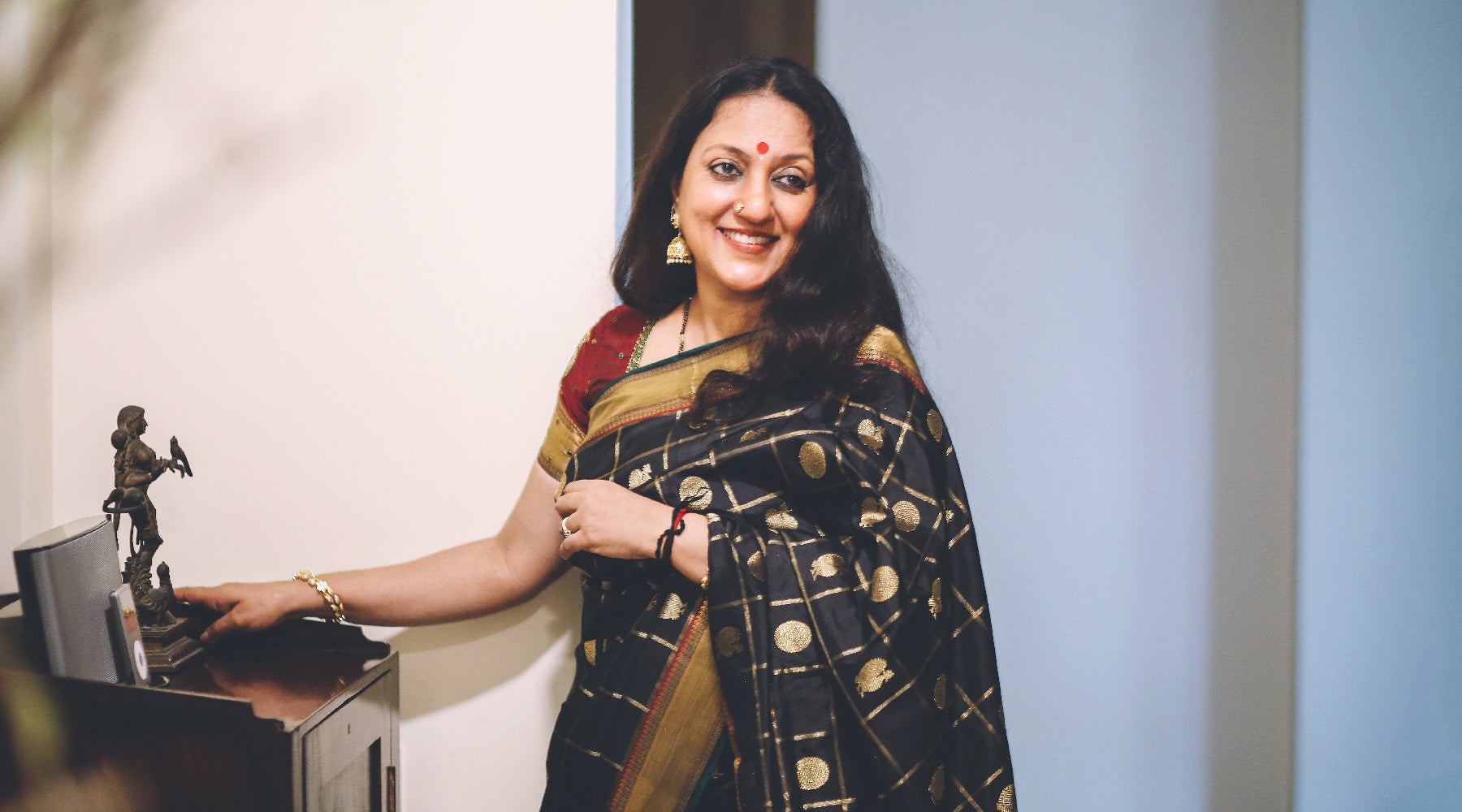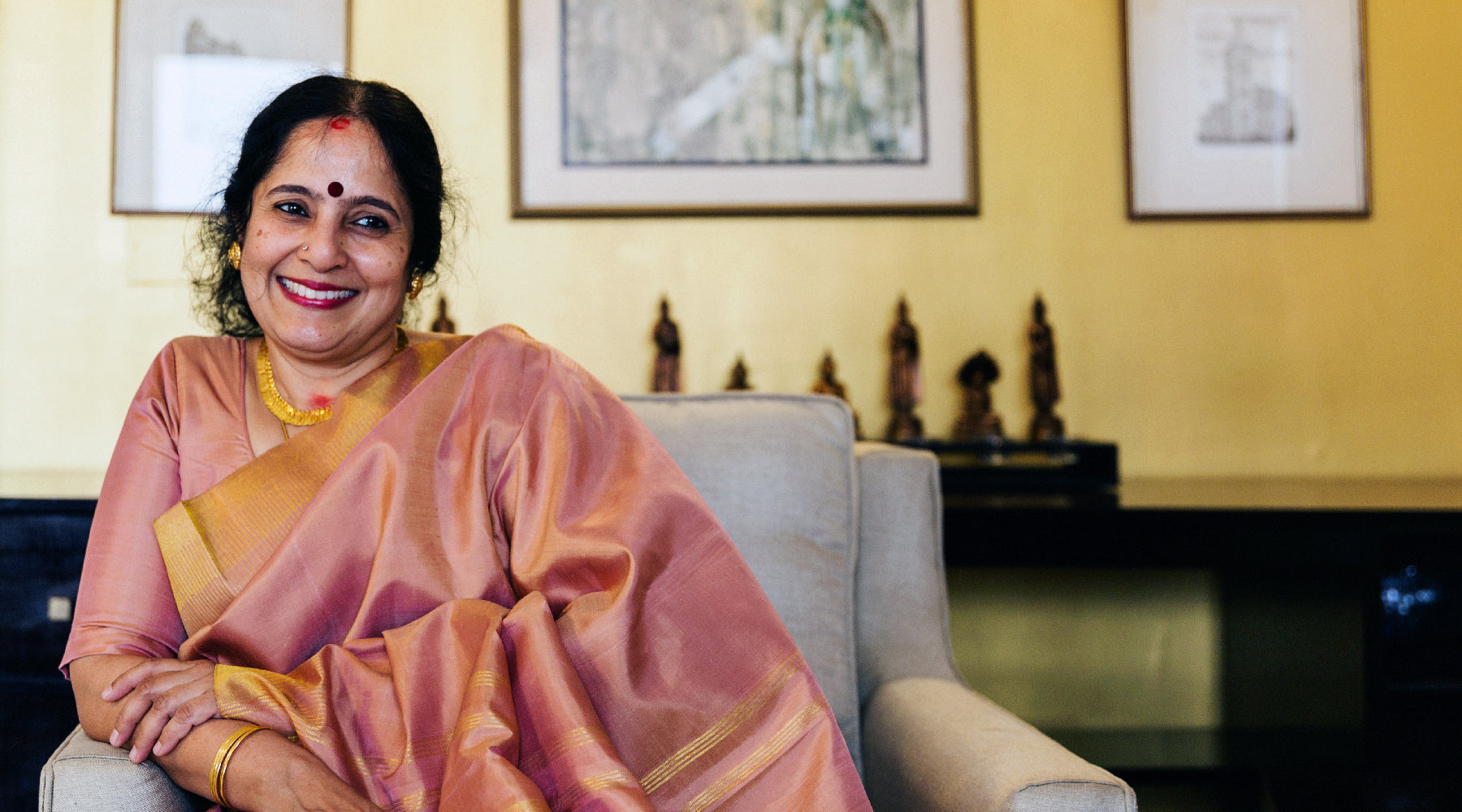KANAKAVALLI VIGNETTES : Mira T.Sundara Rajan - Kaleidoscope
At the heart of everything that Mira T. Sundara Rajan does is a deep love for the arts. One of the world’s foremost legal experts specialising in the moral rights of the author, Mira is a professor, a writer and a trained classical pianist.
As the great- granddaughter of the legendary poet and Indian nationalist Subramania Bharati, Mira grew up surrounded by music, poetry and literature, in a family for whom education was central. In April’s Vignette, Mira speaks with Aneesha Bangera of the Kanakavalli Journal, joining the dots between the many roles she inhabits, opening up about the special bond she shares with her mother, and recalling the first time she wore a sari. The sari fascinates her, she says, connecting her to her ancient past, while allowing her to do everything she needs to, from riding a bike to giving a lecture.
On a recent visit to India, Mira took time out of her busy travel schedule to curate a range of her favourite kanjivarams for us.
Excerpts of the conversation below…
KALEIDOSCOPE
Can you trace your love for music, reading and writing - when and how did you discover this passion?
Arts and culture have always been a part of my life, and the answer to that, I think, lies in my family background. Both my parents are responsible for inspiring a great love in me for music, poetry and literature. My mother is the first scholar who specialised in the works of Subramania Bharati, her grandfather and my great- grandfather. She was brought up by her grandmother, the wife of the poet, and was always very involved in his poetry and writings. And I was born into that environment. My mother would sing his songs to me, as the oral tradition by which the poet taught his own works to his wife and children was very important in our family. My father was an English professor, who did some writing himself and worked with radio. I feel privileged to have grown up in a home so rich in culture and tradition.
What brought you to the field of law?
In our family, education is of the greatest importance. My mother’s grandmother in particular felt very strongly about this. My great-grandmother lived in a time when Indians were downtrodden, and the situation of women, in particular, was abysmal. She had no access to a formal education, but had memorised all the works of her poet husband. My grandmother became a writer with no formal training, and my mother and uncle were the first to receive good educations; both got their PhDs. Education was, in a real sense, a priority in my family. I was encouraged to aim for the highest level of university education. My great-grandfather had written an article on women’s education titled ‘Pudumaipen’, in which he outlined what he thought a modern woman should be – educated and empowered. The modern woman would write the laws for the land, he said, and law was a very well respected and prestigious profession.
I think I had a natural flair for the subject, as it is a verbal profession in which writing and speaking are important. So, I went on to get four university degrees, at five different universities in Canada, France and the UK. My PhD is in Copyright Law from Oxford University. In my career, I have had a special involvement in the moral rights of the author. I think I have a claim to being the foremost academic in the world in this field, alongside one or two other experts.
Can you tell us a little bit about the interplay between the arts and the law in your life and work?
It was in the early years of my legal education that I was exposed to concepts of copyright law, and I realised I had a very important copyright issue within my own family. Bharatiyar’s copyright is a unique case in Indian history, because the government of India bought his copyright and gifted it to the people of India. This means that any Indian national has the right to publish his works. While this is wonderful, it also gave rise to some problems – poems by others were credited to him, there were errors in publication, and no authentic edition of his work was established.

As a law student, I found that something I really cared about tied into my legal studies and copyright became the perfect fit. I began playing classical piano when I was eight years old, and I wrote my first poem at the age of seven. I sometimes think I started my musical education before I was born! Literature and music were very natural callings for me, unlike law. Law came later, in my 20s, and when I came upon it I realised that it could be a way of advocating for the arts. It could be a tool to preserve cultural landmarks, passing them on to the next generations. Most people working in law come from families who have worked for generations in the field, but I saw my background as giving me something special. Becoming an advocate for the arts was a natural extension of my work. Law also contributed to my practice of the arts; it has enabled me to travel all over the world, speaking to all kinds of people. I have had the chance to address the Carnatic music community, to work with museums…and in the process I have come across so many different perspectives; it has been an enriching experience. Law has given me a systematic way of thinking about accomplishing goals and projects in creative fields.
How does your writing complement your work as a law researcher and professor?
I don’t think that writing is something I could have avoided while growing up! The importance of good writing and expression was always emphasised in my home. I think that anyone can become more effective in their own context just by honing their writing skills. I often joke that I’m a misfit in the legal profession – I am a writer who is masquerading as a lawyer. This is true in some ways, but on the other hand I think that my skill as a writer is what has helped me become successful at my legal work. I have been able to write and bring attention to issues that I think are important. I try to make concepts interesting for people to read, presenting convincing arguments.
Are you and your mother close? Tell us a little about the relationship you share.
My mother is a very special person. She comes from this incredible cultural heritage, from an oral tradition of poetry. She was brought up not just by her mother but by her grandmother as well, and was inspired by them to get an education. A great scholar and writer in her own right, she was the first person to specialise in the works of Subramania Bharati for her PhD. Having received her PhD back in the 60s, my mother was a pioneer, setting an example for women everywhere. She doesn’t and has never had a conventional idea of what a woman’s life should be. She’s an unbelievable person and I had the immense privilege of growing up in her care. I’m still very close to her, and am amazed by her constant creativity. She has had a tremendous influence in terms of inspiring me to get educated and be active in the arts. She’s an advanced Carnatic musician herself and wanted me to be educated in music, which she considered essential for developing an appreciation of the higher aspects and refinements of life. Because we were living in Canada when I was growing up – my parents had moved there for my father’s studies – she started me on Western classical music, choosing the piano, which I think is the perfect instrument for me.

Mira with her mother Dr. S. Vijaya Bharati
Your mother has been committed to bringing out a standard edition of the works of your great-grandfather, the legendary Subramania Bharati. Would you like to tell us about this project?
My mother has remained incredibly creative through her life and has also always been plugged into technology. For the book, her goal was to produce a perfect edition of Bharati’s poems, completely free of errors of any kind. In addition, she has written scholarly commentary and introductions to each of the four volumes, sharing her immense knowledge with the reader. She didn’t have complete confidence in the ability of any publishers she knew to produce the books to the standard she wanted to, and always said that one day she would become a publisher herself. And she did just that. My mother decided to use the Amazon self-publishing platform, and has basically constructed the book from scratch. Every single element has been done personally by her – from the cover that features his original signature in English and in Tamil, to every word and every note. When people found out about the project, many expressed their support. The compositor of the cover, a South Indian professional, provided concrete help – preparing the cover to her specifications, and then refusing payment for his work on the books. I believe these works truly represent the coming together of technology with culture.

What does the sari, and the kanjivaram in particular, mean to you?
The first time I came to India as a teenager was in the late 1980s. At the time, my parents decided to quit everything in the Canadian town we lived in to travel for a full year, of which we spent six months in India. As soon as we landed, my mother took me to buy a sari. In those days, Western clothes were not so widespread, and in South India, girls and women all wore davanis and saris. Putting on a sari was a mystery to me at the start, but my mother said that you have to wear the sari properly – the way you put it on and the way you carry it must be graceful, and I learned to enjoy the process of pleating and folding and tying the sari. I see the draping of the sari as a traditional art, and it’s always fascinating to think that when we do this, the sari unites us with the ancient past of our culture. Over the years I’ve discovered that you can do anything in a sari. On subsequent trips to India, I stayed in Pondicherry and would ride a bike in a sari. I have visited law schools across India as a visiting professor and taught in a sari. I think it functions as an Indian suit. In the West, I love beautifully tailored suits, and to me, wearing a lovely kanjivaram is the equivalent. I love the sari, it is my go-to outfit in India.

What's the story behind the sari you chose to wear for the Vignettes shoot?
The sari that I’ve chosen for Vignettes is one of Ahalya’s that I bought on my last trip to India. I chose this particular gold sari because my mother loves it on me – it reminds her of one of Bharatiya’s poems about his wife Chellamma, in which he describes her body as if it was ‘made out of gold’. The colour of the sari and my skin match perfectly, my mother says. We also discovered Ahalya’s jewellery, and I bought a pearl and bangle set in similar tones that goes beautifully with the sari. We really appreciate Ahalya’s ethos and what she is doing with Kanakavalli. She is creating a unique brand, keeping tradition alive while constantly celebrating innovation.
- Mira T.Sundara Rajan in conversation with Aneesha Bangera, photography by Raghuram Vedant
Explore Mira's Kanakavalli curation here



